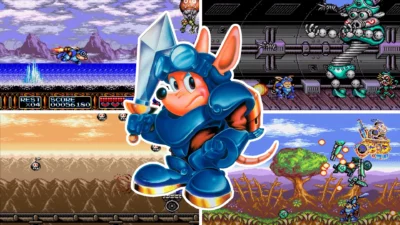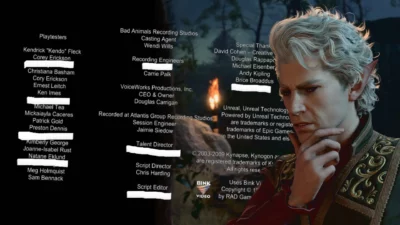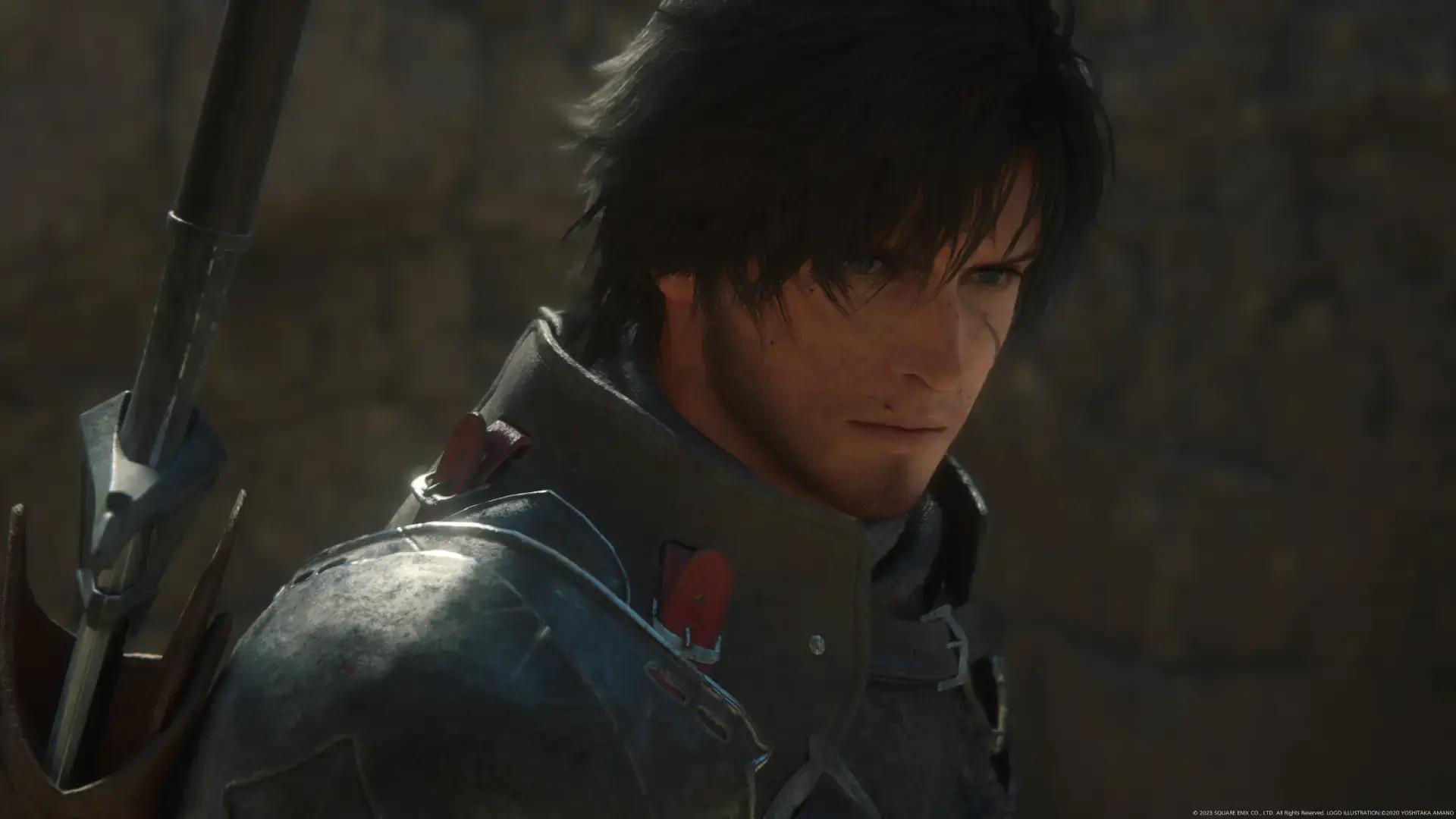
Need help mastering the real-time combat in Final Fantasy XVI? From precision dodging to using Eikon abilities, here’s the only guide you’ll need.
The first mainline Final Fantasy title in almost seven years is a radical departure from its predecessors. Although it’s not the first time the series has moved away from traditional turn-based combat, Final Fantasy XVI goes further by ditching both party and command-based mechanics (although you’ll still have party members – they’re just AI-controlled). FFXVI plays like a pure real-time action game, courtesy of combat director Ryota Suzuki (Devil May Cry 5, Dragon’s Dogma). Action masters PlatinumGames also supported the game’s development.
While traditional RPG players less used to real-time combat may wish to equip a number of accessories to make it more approachable, this guide is for players who want to engage with the pure action experience, although whatever your playstyle preference, you’ll also find useful information regarding the different Eikon abilities, how best to use them, and other ways to help survive encounters with the game’s more formidable enemies.
Defences first
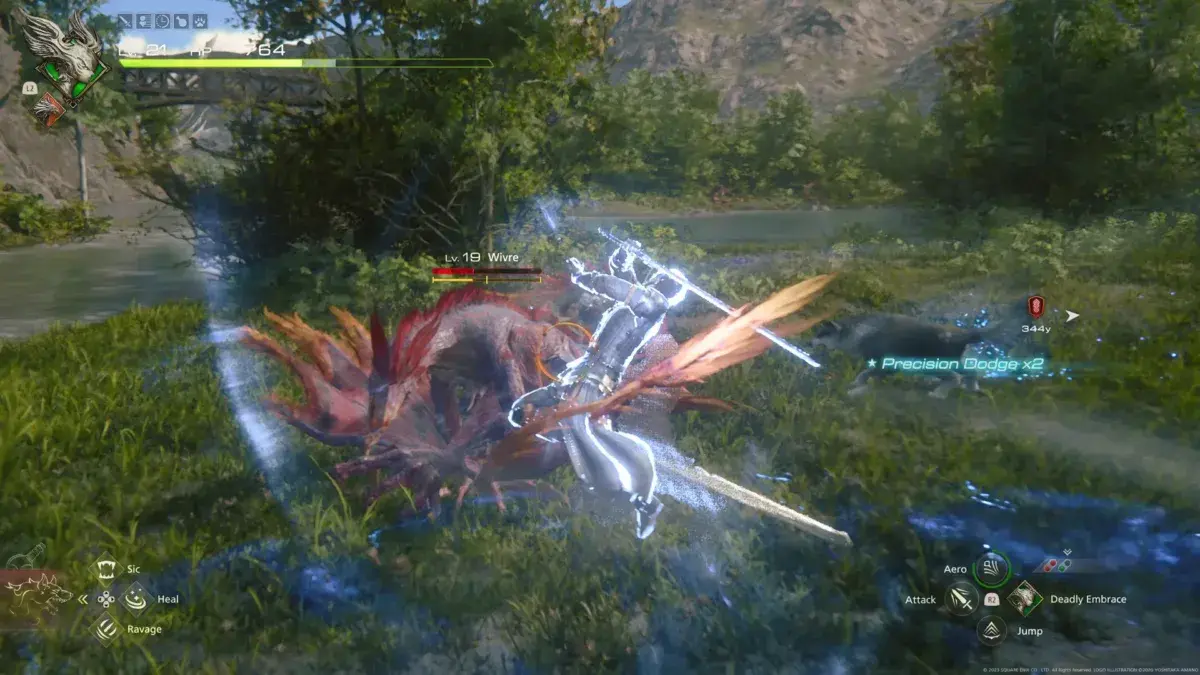
Credit: Square Enix.
While you’ll likely want to get straight into hacking and slashing, let’s cover defence first. Despite having the title of First Shield of Rosaria, your protagonist Clive Rosfield – ironically – doesn’t have a shield. Instead, his defence comes from either evading or parrying attacks.
Evading is done by tapping R1 to dodge incoming enemy attacks. However, to really get the most out of evading, you’ll want to time it so that you dodge at the very last moment. This is a Precision Dodge, and not only does Clive evade attacks with more flair, he can also follow up immediately with a counterattack, using Square to jump back in with Precision Strike or Triangle for a Precision Shot. You’ll want to consider the best counter to go with depending on range. For instance, if you precision dodge a ranged attack, your melee counter has a bit of reach, but go too far and you’re more likely to waste it and hit the air.
Another benefit of Precision Dodge is you’ll be able to evade virtually any attack when executed properly, whereas a regular evasion leaves you briefly unable to dodge again immediately, so spamming it risks you being caught out by mobs or a combo.
Parrying is similar to Devil May Cry, where you have to attack the enemy just as they attack, and if successful, this temporarily slows time, allowing you to follow-up with any punishing counter you like, such as an Eikon ability. The timing of this requires near-perfect precision less your attack merely disrupt their animation or you’re just a bit too late and get hit. It’s for this reason we’d recommend prioritising evasion, although you can always visit the Hall of Virtues to practise the parry timing.
Breaking the enemy’s will
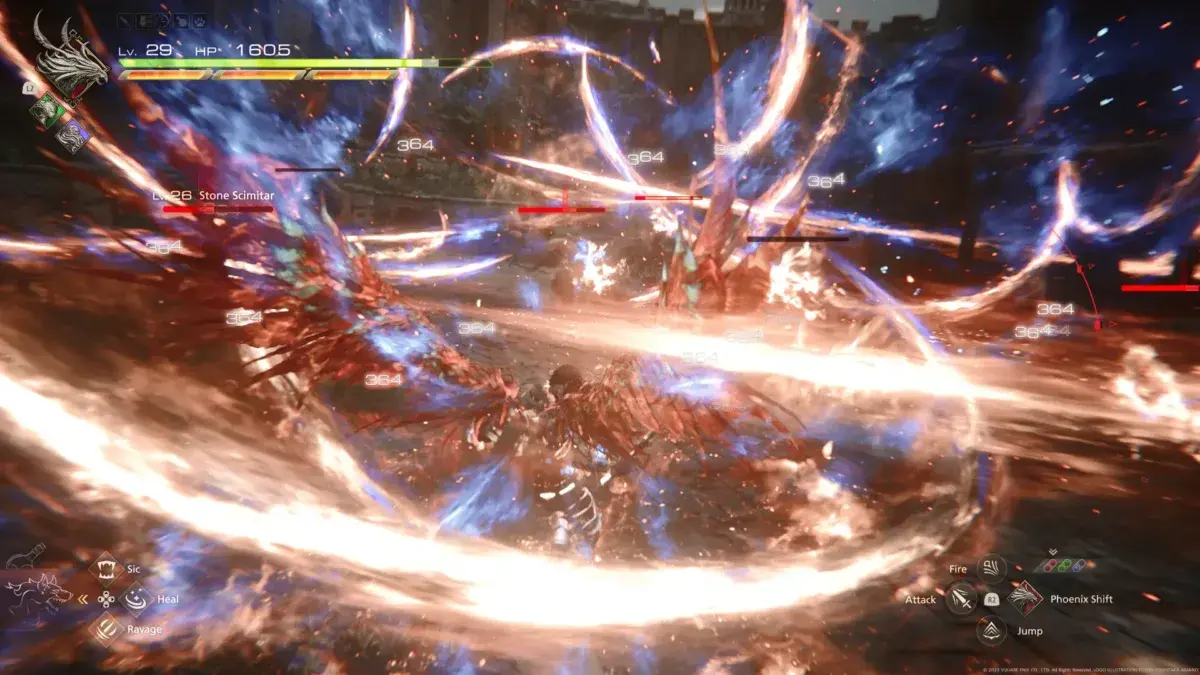
Credit: Square Enix.
While your focus is on defeating enemies by hacking down their health bar, you also want to pay attention to their will, equivalent to a stagger meter in games like Nioh and Final Fantasy VII Remake. Formidable foes (basically mini-bosses, or simply a bigger, tougher enemy, and onwards) will have this meter just beneath their health bar, which goes down as you continue attacking. When the meter has been depleted, their will is broken, leaving them in a state of stagger, where all your attacks will now deal more damage, so this is the best time to unleash your most powerful attacks before the meter recovers and the process starts again.
One difference from other stagger systems is that you can also partially stagger an enemy just by bringing their will gauge down to 50%, which briefly leaves them open to a punishing combo, and can also be exploited with Garuda’s Eikonic Feat.
We’ll get into more details on specific Eikon abilities later, but as these are cooldown-based, you’ll want to consider whether you want to use these abilities to reduce the enemy’s will quicker or reserve them for when they’ve been staggered so you can unleash maximum damage. As you unlock more Eikons, this will become a bit easier to balance, although you can also check the Abilities screen and select each Eikon ability where it will show the star rating for its capacity for dealing damage and its capacity for breaking will. For instance, Phoenix’s Rising Flames has a 3-star rating for damage and 2-star for stagger, which means you should prioritise using the ability when your target has been staggered.
Elementals and enemy buffs
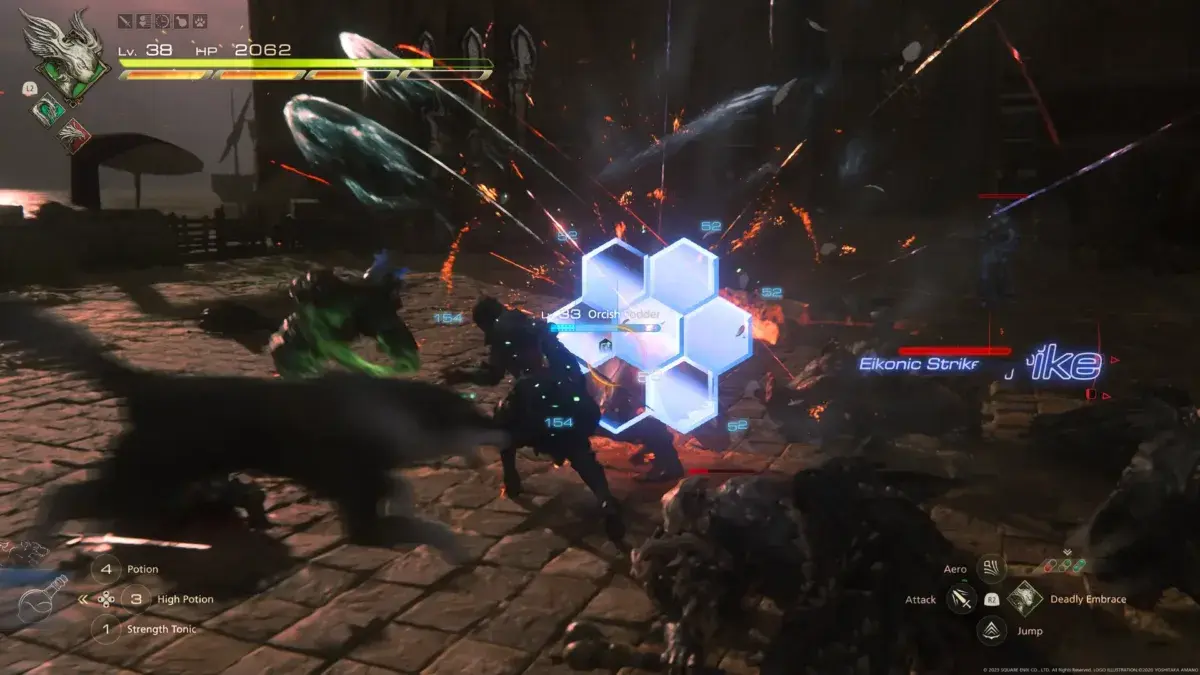
Credit: Square Enix.
Traditional Final Fantasy games, as with other RPGs, usually have a rule about using the right elemental magic to exploit an enemy weakness. But given you start with the fire-based power of the Phoenix, does that mean you’ll have a disadvantage against other fire-based enemies? Not at all. Elemental weaknesses fortunately doesn’t really apply in Final Fantasy XVI so feel free to use the Eikons that work best for you, although we do have recommendations when it comes to what abilities to use.
Nonetheless, you’ll still encounter some magic-casting enemies who are able to give their allies advantages with some familiar buffs from the series.
Cure is straightforward, healing nearby enemies, so you’ll want to make sure you kill the healer first. Protect meanwhile casts a protective barrier around an enemy that normal attacks will bounce off of, in which case make sure you use an Eikon ability to break the barrier first. Bravery, meanwhile, buffs an enemy’s attack so if you see someone with that symbol above them, make sure to take care of them first to avoid getting dealt more damage.
To heal or not to heal?
Since you have a limited number of potions you can carry, you might not want to use a potion immediately when your health has taken a beating. One thing you may notice is that when you’ve taken damage, a part of your health bar will be translucent, which is a bit like grey health in fighting games that can be regained over time.
Using Torgal’s command to heal, this lost health can be healed, but you can also recover it all when you’ve unlocked and use the Phoenix ability Flames of Rebirth. Another way to recover health beyond what can be regained is once you unlock Limit Break, which besides greatly boosting Clive’s powers and stats also slowly restores health, and if you’re attacked during this state, even if your HP is all gone you won’t die as long as your Limit Break gauge hasn’t been depleted.
So consider these factors before quaffing a potion straight away. That said, you also don’t need to stress too much during story quests as bosses have checkpoints, while retrying from these checkpoints also replenishes your potion supply.
Best abilities to unlock first
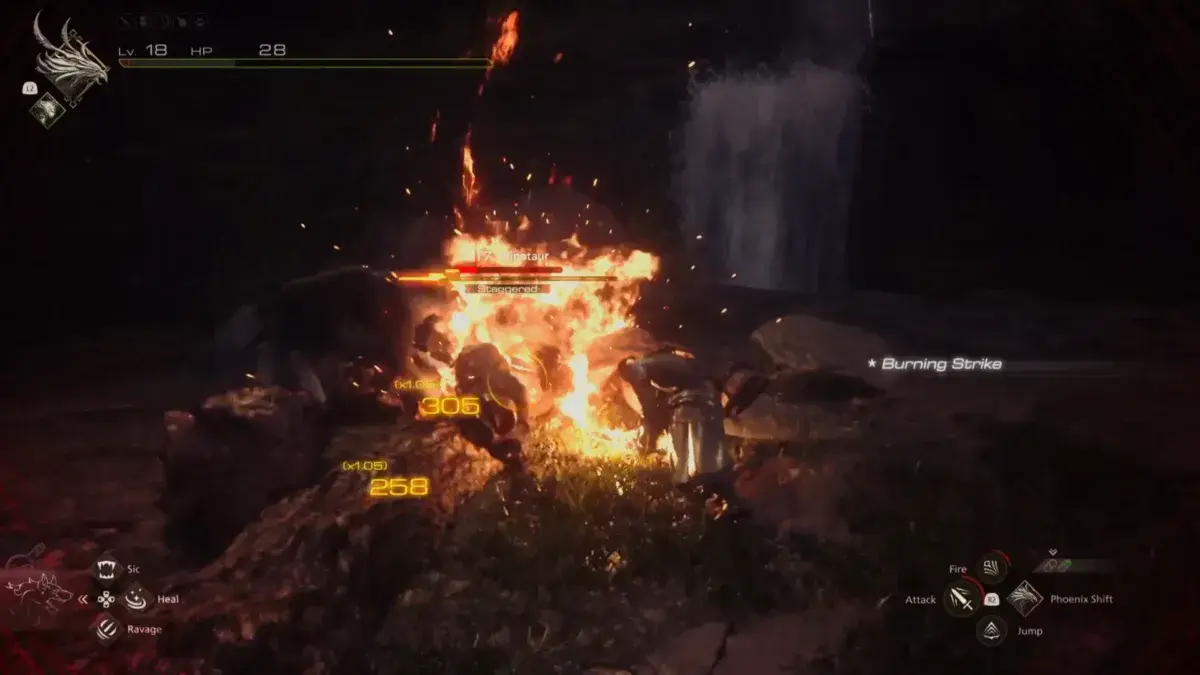
Credit: Square Enix.
Clive starts off with a few abilities as well as the power of the Eikon, with more that can be unlocked with Ability Points earned throughout playing the game and completing quests. Some abilities cost a lot to unlock, upgrades usually even more, but here’s a few we’d recommend spending points on first.
Swift Recovery – Try as you might to dodge, there’s going to be times that you’ll get knocked on your backside, so being able to recover immediately with R1 as you get knocked down so that you can immediately get back in the fight is important. Costs 10 Ability Points.
Burning Blade – Although you might think it’s best to string combos together, there’s nothing quite like holding down Square to charge up a powerful melee attack, which can also work for breaking an enemy’s guard or in a timed parry. Early on, if your Eikon abilities are all on cooldown, we find that Burning Blade is very effective for dealing damage to staggered enemies, which also makes the skill worth mastering so that you reduce the charge time. In fact, once you unleash the attack you can immediately hold Square again mid-animation to immediately start charging, and if you’ve mastered it, it’s more or less ready to use after the previous attack has landed. Better yet, it also works following a precision dodge or Phoenix Shift. Costs 25 Ability Points to unlock, and 180 to master.
Lunge – While you have the Phoenix ability to warp-dash towards enemies, this is another effective way to close distance by pressing X and Square at the same time. Costs 25 Ability Points to unlock, and 200 to master, which increases lunge distance.
Swift Recovery – Try as you might to dodge, there’s going to be times that you’ll get knocked on your backside, so being able to recover immediately with R1 as you get knocked down so that you can immediately get back in the fight is important. Costs 10 Ability Points to unlock.
Precision Dodge master – You already start with this ability but since it’s your best defence and counter, it’s worth mastering early on in order to get a more generous window. Costs 500 Ability Points to master.
Best Eikon abilities to use and unlock
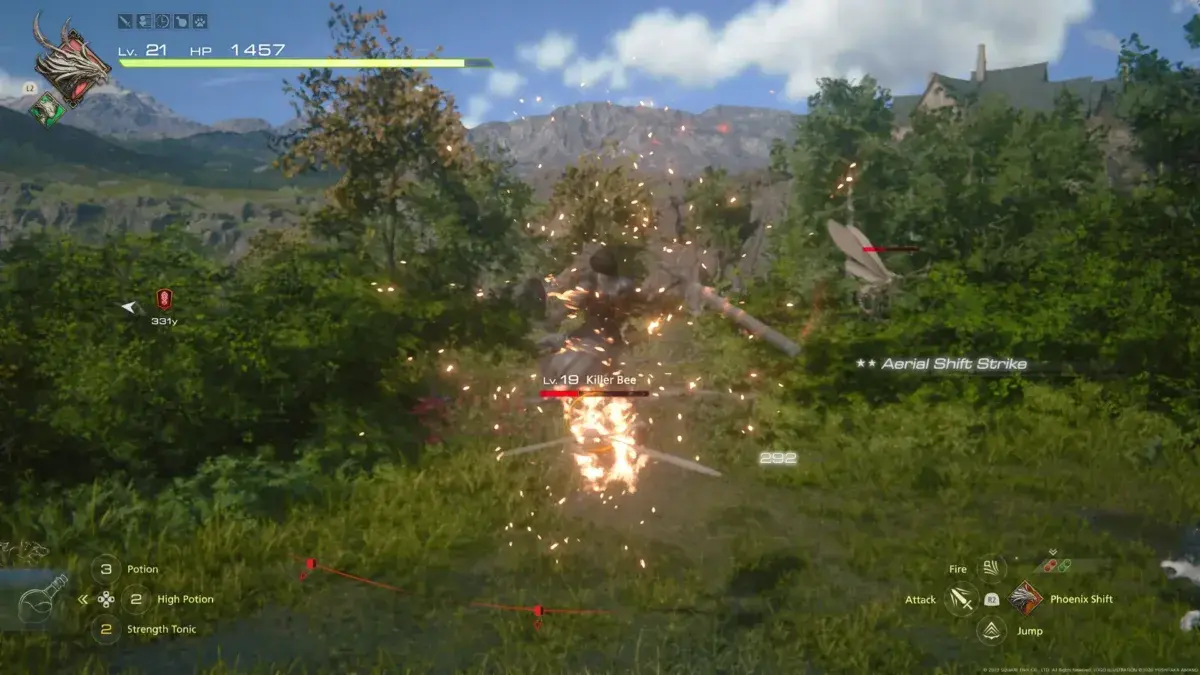
Credit: Square Enix.
Even though you only play as Clive, he can fight with not just the power of the Phoenix but also of other Eikons as the game progresses, with the ability to equip up to three Eikons at any time, using L2 to cycle between them. There’s seven Eikon abilities altogether, and the way you unlock them is somewhat spoilery, so we’re going to just focus on three that we find you’ll want to stick with for a good portion of the game.
As you unlock a new Eikon, you’ll find each has an Eikonic Feat activated with Circle and two Eikon abilities, activated by holding R2 then pressing Square or Triangle depending on which button it’s been mapped to. You can unlock two further abilities although only two abilities can be equipped for each Eikon. You can also master an ability, allowing it to be equipped to a different Eikon. It’s not going to be necessary to master any Eikon ability until you have more than three Eikons unlocks, not to mention mastering costs at least a hefty 1,000 Ability Points each. If you’ve unlocked or upgraded an ability you find you end up not using, then be sure to reset and respec so you can spend those points elsewhere.
Phoenix:
Eikonic Feat – Phoenix Shift: this lets you warp-shift towards enemies, great for closing distance, which you can also immediately follow up with a melee or magic attack. This also works against aerial enemies, or indeed enemies you’ve launched in the air, which basically allows you to air juggle. This feat alone makes it worth keeping the Phoenix equipped for the whole game. Master with 375 Ability Points to increase shift distance.
Best ability – Flames of Rebirth: While this is an expensive unlock, this summons a huge pillar of fire that’s great for taking out multiple enemies within your vicinity, and does equally high damage and staggering. More importantly, it’s a good way to regain lost health. Costs 1,695 Ability Points to unlock, 2,390 to upgrade, 4,250 to master.
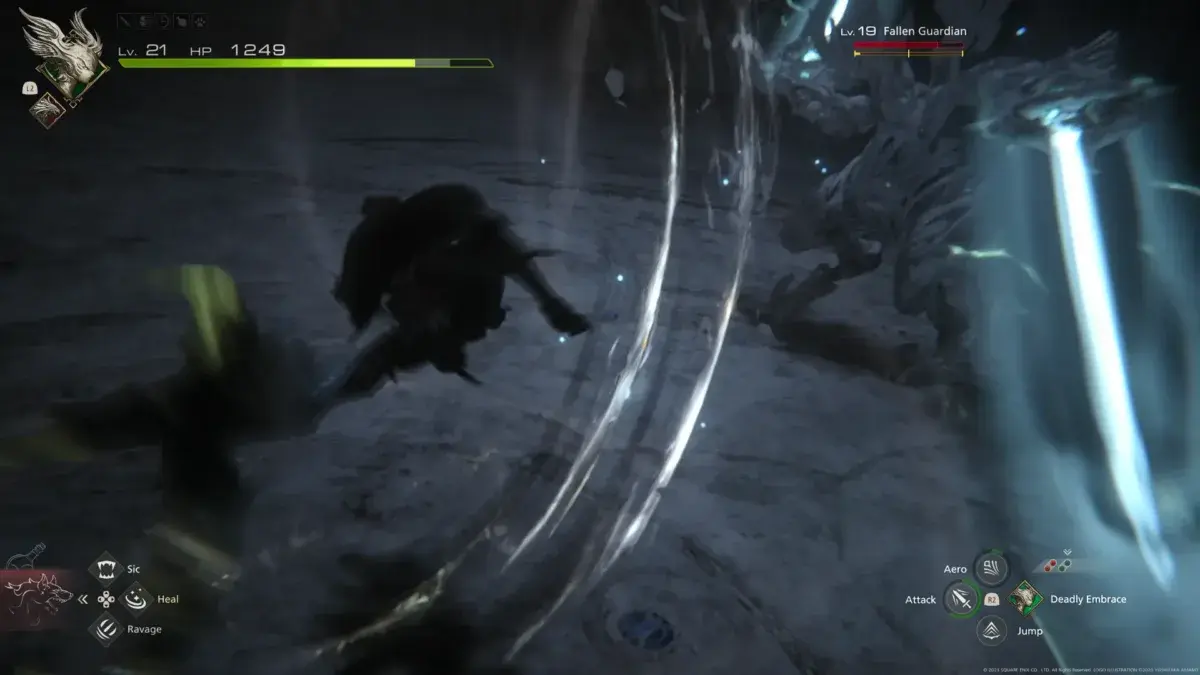
Credit: Square Enix.
Garuda:
Eikonic Feat – Deadly Embrace: Sort of the opposite of Phoenix Shift in that rather than rushing towards enemies, you bring the enemies to you with a grappling claw, which also works for pulling down aerial enemies. On stronger enemies with a will meter, it just launches Clive in the air instead but the reason why it’s really worth keeping this Eikon is that when you partially stagger one of these enemies, using this Feat will topple them to the ground, giving you even more time to exploit your most punishing attacks, if not with as huge a window as a stagger state itself. Master with 450 Ability Points to increase claw distance.
Best ability – Rook’s Gambit: This is an additional ability to unlock but one that’s for players who like to counter. When used, you’ll jump back then follow back in with a Gambit Counter. The trick is to time this just right, much like Precision Dodge, which not only looks cooler in action but increases the counter strength while also reducing the cooldown time by a third. This makes it an excellent ability for breaking a formidable opponent’s will. Costs 120 Ability Points to unlock, upgrade with 660 to increase number of hits from Gambit Counter, master with 1,000 points.
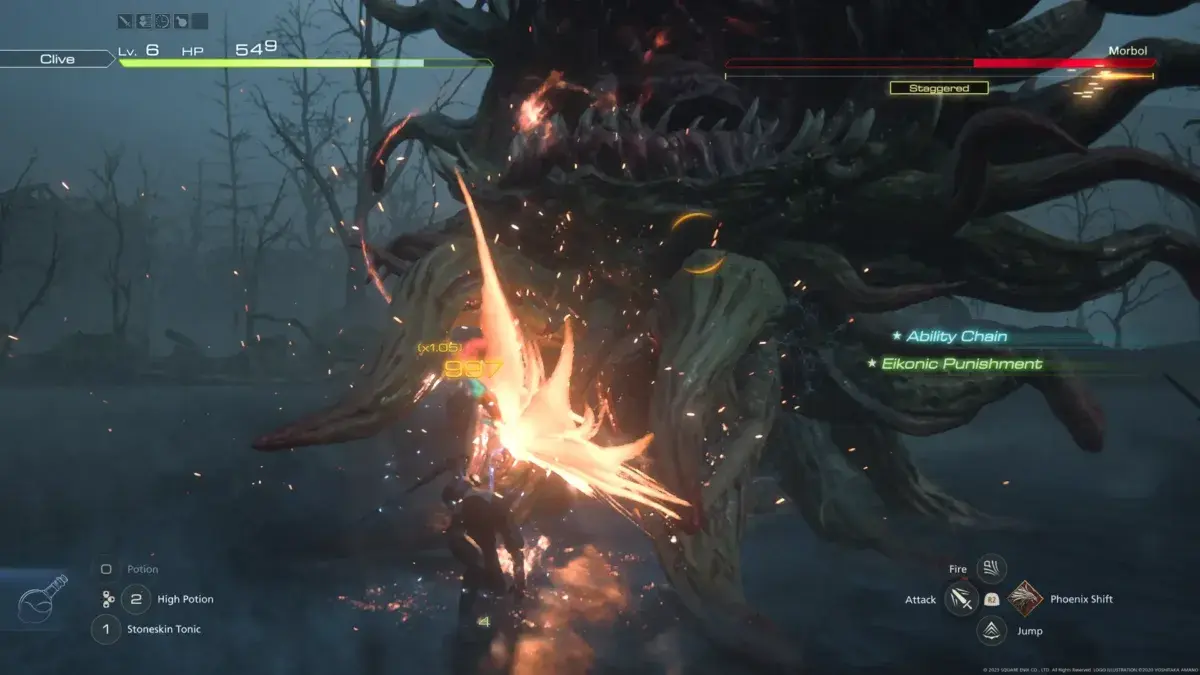
Credit: Square Enix.
Titan:
Eikonic Feat – Titanic Block: So Titan’s fists are the closest you get to a shield as holding it will block all but the most powerful unblockable attacks, though repeated attacks will also break your guard. However, this is also the feat for players who like to parry and riposte like in a FromSoft game. If you perfectly time the block, it becomes a Precision Block, indicated by a very bad-ass crash-zoom, which can be immediately follow up with Square to launch up to three counter punches. Mastering this feat also fills the Limit Break gauge. It’s less effective against crowds but very good for one-on-ones such as boss fights. One other thing to bear in mind is that a Precision Block doesn’t completely disrupt an enemy’s combo so you sometimes have to parry the whole combo before following up with your own. Master with 800 Ability Points.
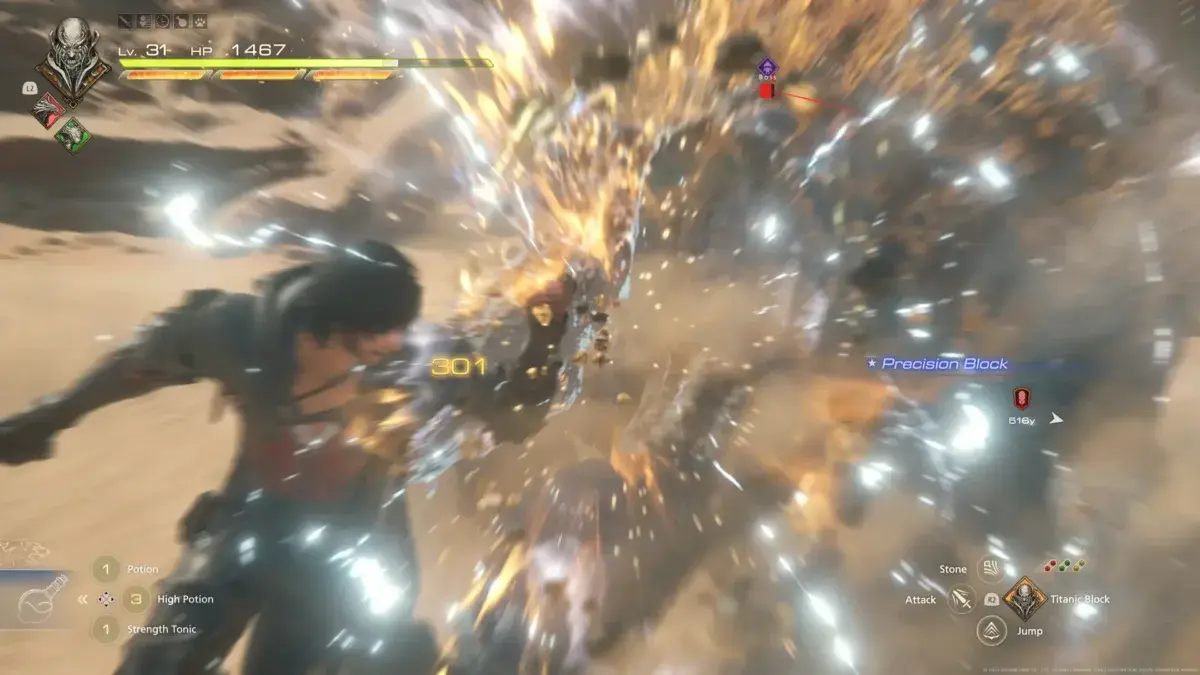
Credit: Square Enix.
Best ability – Windup: This powerful forward punch is a starting ability for Ttian and great for a whole lot of damage against a single enemy, But to get the most out of it, you want to execute a Precision Windup, which means holding the execution button down. A charging wheel appears on screen, with an area in red. Release the button when the marker hits the red zone and you’ll deliver even more damage. It’s worth upgrading in order to widen the precision window. Given the charging time involved, this is best used against a staggered enemy for maximum effect, so that you don’t get interrupted by an attack. Upgrade with 660 Ability Points, master with 1,000.
Combos and rankings
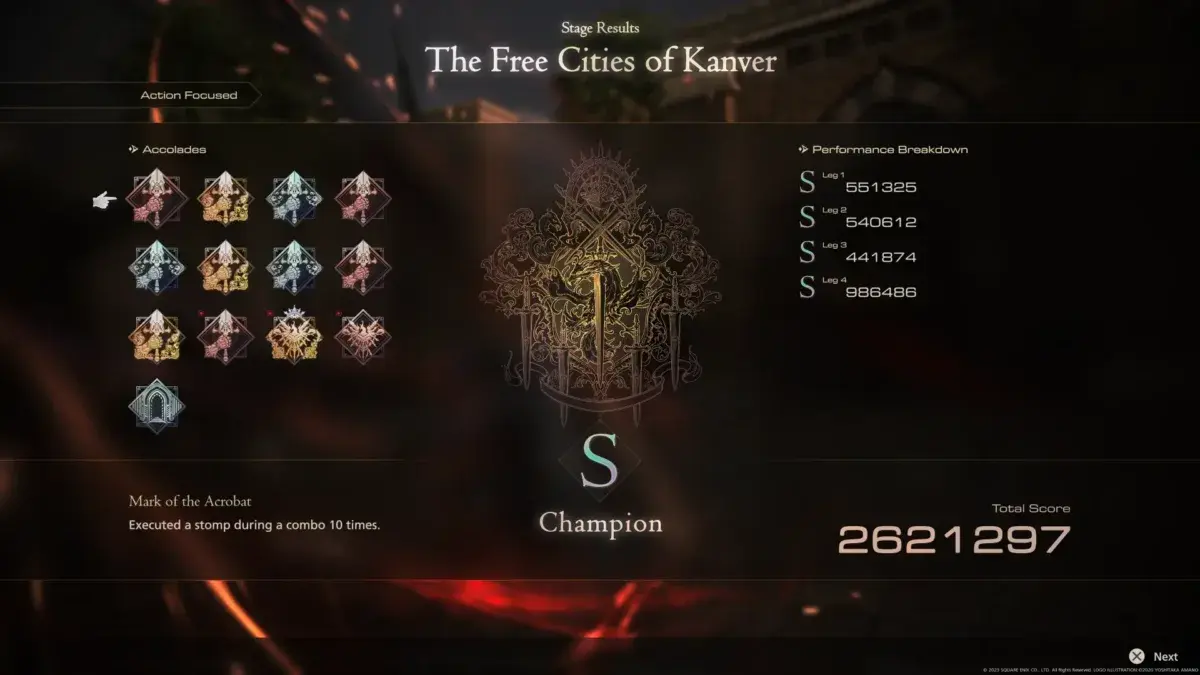
Credit: Square Enix.
You can enjoy the depth of the combat system from the campaign alone but if you really want to gauge just how well you’re fighting then the good news is there’s a Devil May Cry-inspired arcade mode that can be accessed via the Arete Stone at the Hideaway hub, allowing you to replay any linear action stage, with a ranking awarded to each leg of the stage.
While the scoring isn’t graded like the Capcom series, or arguably as demanding, there’s nonetheless a colour-coded score system, where basic attacks techniques will be coloured in white, and as your performance improves, the colour ranking goes to blue, cyan, green, and then rainbow. This colour system can also be seen throughout the game, but you’re only scored in arcade mode.
Getting the best score will really come down to using your Eikon abilities as well as mixing up your attack styles, so be sure to make the most of every ability you have equipped and look stylish as you fight. In any case, there’s no rewards or online leaderboards in this mode at the time of writing, so it’s all down to personal glory. Have fun!
Read more: Final Fantasy XVI starter guide | 10 key tips for beginners


